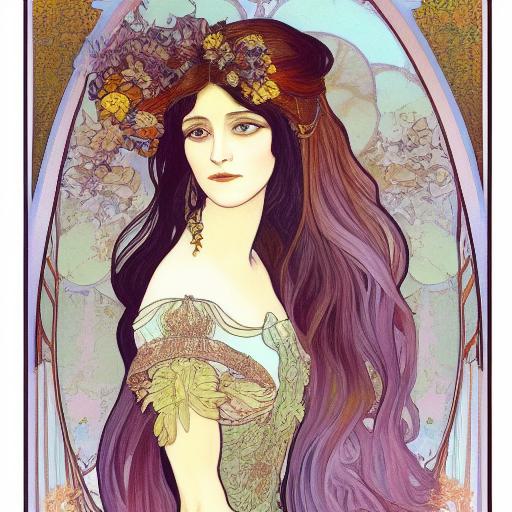Art Nouveau and its supporters
Art Nouveau, meaning “new art” in French, was an influential art movement that emerged in the late 19th century and flourished until the early 20th century. It was a revolutionary departure from the academic and historical art styles that dominated the art world at the time. Art Nouveau encompassed various artistic disciplines, including architecture, interior design, decorative arts, and visual arts.
The movement emerged as a response to the industrialization and technological advancements of the era, seeking to break away from the rigid constraints of traditional art and embrace a more organic and innovative aesthetic. Art Nouveau aimed to create a harmonious fusion of art and life, incorporating elements of nature, fantasy, and modernity into its designs. It celebrated the beauty of natural forms, with a particular emphasis on curves, flowing lines, and intricate patterns.
Art Nouveau found its roots in the artistic ideas and philosophies of several influential figures. One key advocate of the movement was the Belgian architect and designer, Victor Horta. Horta’s innovative architectural designs, characterized by intricate ironwork, curvilinear structures, and ornamental details, became emblematic of Art Nouveau. Another significant figure was the French art critic and curator, Siegfried Bing, who played a pivotal role in popularizing Art Nouveau through his influential gallery, Maison de l’Art Nouveau, in Paris.
The movement gained traction across Europe and had a profound impact on various art forms. It found expression in the works of renowned artists such as Alphonse Mucha, Gustav Klimt, René Lalique, and Émile Gallé, each contributing to the development and evolution of the Art Nouveau style. Notable examples of Art Nouveau can be found in architectural landmarks like the Hôtel Tassel in Brussels, the Casa Batlló in Barcelona, and the Paris Metro entrances designed by Hector Guimard.
Color Using In Art Nouveau
Color played a vital role in the works of Art Nouveau, contributing to the overall aesthetic and enchanting quality of the art movement. Art Nouveau artists embraced a rich and vibrant color palette, utilizing a wide range of hues to create visual harmony and evoke emotional responses in the viewers.
In Art Nouveau, colors were often inspired by nature, with an emphasis on earthy tones and organic shades. Warm colors such as deep reds, rich browns, and golden yellows were frequently used to evoke a sense of warmth and opulence. These colors were reminiscent of natural elements like autumn leaves, sunsets, and the warmth of candlelight.
At the same time, Art Nouveau artists also incorporated cooler colors to balance the warm tones. Shades of blues, greens, and purples were used to represent water, flora, and the ethereal qualities of the natural world. These colors added a sense of tranquility and serenity to the compositions, enhancing the overall dreamlike and mystical atmosphere of Art Nouveau.
One distinctive characteristic of Art Nouveau color usage was the application of color in a harmonious and organic manner. Artists sought to create a seamless integration between the subject matter and the colors used, often blurring the lines between the figure and the surrounding environment. This approach created a sense of unity and fluidity, reinforcing the movement’s emphasis on the interplay between art and life.
Complete your work with AI image generator
In the realm of art, where imagination knows no bounds, we can created a painting that unveils the elegance and allure of a woman with prompt and AI image generator such as Imagen and Midjourney. This particular artwork portrays a woman with flowing, long hair, gracefully adorned in a captivating long dress. Inspired by the iconic artist Alsphonse Mucha and the enchanting Art Nouveau movement, this painting transports us to a world of timeless beauty and artistic expression.
The influence of Alsphonse Mucha’s distinctive style resonates throughout the artwork. Modern Art Nouveau elements merge with the traditional, resulting in a captivating fusion that breathes new life into the genre. The elegant lines and flat compositions characteristic of Mucha’s work become the foundation upon which this painting is built, giving it a sense of harmony and balance.
As we immerse ourselves in the scene, we find the woman surrounded by the beauty of a lush garden. The colors and shapes of various flowers burst forth, creating a vibrant tapestry of nature’s finest. Each petal, each leaf, meticulously painted to convey the delicate intricacies and textures. Flowers, in their timeless symbolism of grace and beauty, find their place as an integral part of the painting, enhancing the woman’s aura and adding a touch of enchantment.
The long dresses worn by the woman exude a sense of elegance and refinement. Their flowing forms and rich patterns further accentuate the Art Nouveau aesthetic, capturing the essence of grace and femininity. The intricate detailing of the dresses adds depth and dimension, showcasing the artist’s attention to minute intricacies that bring the artwork to life.
This painting invites us to appreciate the serene and captivating atmosphere of a garden. It serves as a window into a world where nature and human beauty coexist harmoniously. Through the skillful use of color, form, and composition, the artist captures the essence of both the Art Nouveau movement and the timeless allure of a woman in a garden setting.
When finish, we can use this images in different using, such as decoration and share it with others. We can also use it as design elements in design tools like Visual Paradigm Online. Enjoy your creation now!


